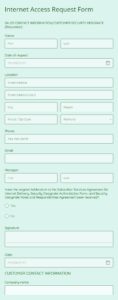An Internet use policy establishes boundaries and guidelines for the usage of internet and computer resources. It ensures safe and appropriate use of technology and the internet within the organization or institution. This policy comprises rules, regulations, and standards to ensure the security, privacy, and accountability of internet activities. Whether you are a school, business, organization, or individual, implementing a well-crafted and internet use policy template is crucial. Here are some points to consider when forming a policy and a sample template.
The purpose of an internet use policy is to define the parameters of network access, ensure the safety and security of users and data, and promote ethical and responsible use of technology. It outlines the organization’s stance on data privacy, cyber security, acceptable use, consequences of misuse, and expected behavior while accessing the internet and company resources. Having a clearly established internet use policy template helps manage online conduct, prevent potential liability, and maintain a positive learning or workplace environment.
Key Elements of an Internet Use Policy Template
1. Purpose: Clearly state the objective of the policy, emphasizing the organization’s commitment to a safe, productive, and secure internet environment.
2. Scope: Define the entities covered by the policy, including employees, students, guests, contractors, and visitors, and specify the network resources included.
3. Acceptable Use: Outline permissible internet activities, such as research, communication, and official work-related tasks. Address prohibited activities like unauthorized access, harassment, copyright infringement, and illegal downloads.
4. Security Measures: Establish policies for login credentials, password protection, anti-virus software, and security patches. Stress the importance of safeguarding sensitive data and preventing unauthorized access.
Additional Considerations for an Internet Use Policy Template
1. Privacy and Data Protection: Detail how user data and information are collected, stored, and used. Adhere to data privacy laws and regulations. Emphasize the need for user consent before collecting personal information.
2. Monitoring and Enforcement: Outline the organization’s monitoring practices and the consequences for violating the policy. Clearly communicate disciplinary actions and the process for reporting violations.
3. Training and Education: Provide regular training and education to inform users about the policy and its implications. Encourage users to actively participate in maintaining a secure and responsible internet environment.
4. Review and Updates: Regularly review and update the internet use policy template to ensure it remains relevant and compliant with evolving laws, regulations, and technological changes.
By implementing a comprehensive and internet use policy template, organizations can foster a safe and responsible online environment, protect their network and data, and ensure the ethical and appropriate use of technology. This policy template allows organizations to establish clear guidelines and expectations for internet usage, reducing the risk of security breaches, legal liabilities, and maintaining a positive workplace or learning environment.
FAQ
What is the purpose of an internet use policy template?
An internet use policy template outlines guidelines and rules for internet and computer resource usage within an organization or institution. It ensures safe, appropriate, and ethical use of technology, safeguarding the network, data, and user privacy.
What key elements should an internet use policy template include?
A comprehensive internet use policy template should cover aspects such as purpose, scope, acceptable use, security measures, data protection, monitoring and enforcement, training and education, and regular reviews and updates.
Who should be covered by an internet use policy template?
The scope of an internet use policy template should clearly define the entities covered, typically including employees, students, guests, contractors, and visitors. It should specify the network resources and devices subject to the policy.
